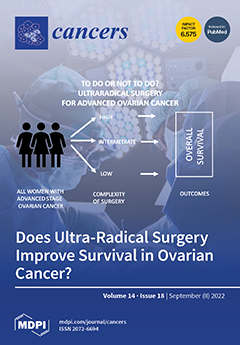Objective: The management of petroclival meningiomas (PCMs) remains notoriously difficult due to their close association with neurovascular structures and their complex anatomy, hence the surgical paradigm change from radical to functional resection in the past. With this study, we aimed to analyze surgical
[...] Read more.
Objective: The management of petroclival meningiomas (PCMs) remains notoriously difficult due to their close association with neurovascular structures and their complex anatomy, hence the surgical paradigm change from radical to functional resection in the past. With this study, we aimed to analyze surgical and functional outcomes of a modern consecutive series of patients with PCMs.
Methods: We reviewed patient charts and imaging data of 64 consecutive patients from 2006 to 2018 with a PCM resected at our institution and compared surgical and functional outcomes between subgroups stratified by surgical approach.
Results: Females comprised 67.2% of patients (
n = 43), with a mean age of 55 years (median 56; range 21–84). Follow-up data were available for 68.8% and reached a mean of 42.3 months (range 1–129) with a median of 28.5 months. The mean tumor diameter was 37.3 mm (standard deviation (SD) 15.4; median 37.0). Infiltration of the cavernous sinus was observed in 34 cases (53.1%), and the lesions affected the brain stem in 28 cases (43.8%). Preoperative cranial nerve palsy was observed in 73.4% of cases; trigeminal neuropathy (42.2%), hearing loss (32.8%), and impairment of vision (18.8%) were the most common. A retrosigmoid approach was employed in 47 cases (78.1%), pterional in 10 (15.6%), combined petrosal in 2 (3.1%), and transnasal and subtemporal in 1 (1.6%). Fifteen cases (23.4%) were resected in a two-staged fashion. Gross total resection (GTR) was attempted in 30 (46.9%) cases without cavernous sinus infiltration and was achieved in 21 (70.0%) of these cases. Surgical complications occurred in 13 cases (20.3%), most commonly meningitis (
n = 4; 6.3%). Postoperatively, 56 patients (87.5%) developed new cranial nerve palsy, of which 36 (63.6%) had improved or resolved on last follow up. Achieving GTR was not significantly associated with higher rates of surgical complications (chi-square;
p = 0.288) or postoperative cranial nerve palsy (chi-square;
p = 0.842). Of all cases, 20 (31.3%) underwent postoperative radiation. Tumor progression was observed in 10 patients (15.9%) after a mean 102 months (median 124).
Conclusions: Surgical resection remains the mainstay of treatment for PCMs, with perioperative cranial neuropathies exhibiting favorable recovery rates. Most essentially, the preselection of patients with hallmarks of brain stem affection and cavernous sinus infiltration should dictate whether to strive for a functionally oriented strategy in favor of radical resection.
Full article






